Book contents
- Frontmatter
- Contents
- List of illustrations
- List of contributors
- Editorial note
- Introduction: Kyklos, the Epic Cycle and Cyclic poetry
- PART I APPROACHES TO THE EPIC CYCLE
- PART II EPICS
- 11 Theogony and Titanomachy
- 12 Oedipodea
- 13 Thebaid
- 14 Epigonoi
- 15 Alcmeonis
- 16 Cypria
- 17 Aethiopis
- 18 Ilias parva
- 19 Iliou persis
- 20 Nostoi
- 21 Telegony
- PART III THE FORTUNE OF THE EPIC CYCLE IN THE ANCIENT WORLD
- Works cited
- Index of principal passages
- Index nominum et rerum
11 - Theogony and Titanomachy
from PART II - EPICS
Published online by Cambridge University Press: 05 August 2015
- Frontmatter
- Contents
- List of illustrations
- List of contributors
- Editorial note
- Introduction: Kyklos, the Epic Cycle and Cyclic poetry
- PART I APPROACHES TO THE EPIC CYCLE
- PART II EPICS
- 11 Theogony and Titanomachy
- 12 Oedipodea
- 13 Thebaid
- 14 Epigonoi
- 15 Alcmeonis
- 16 Cypria
- 17 Aethiopis
- 18 Ilias parva
- 19 Iliou persis
- 20 Nostoi
- 21 Telegony
- PART III THE FORTUNE OF THE EPIC CYCLE IN THE ANCIENT WORLD
- Works cited
- Index of principal passages
- Index nominum et rerum
Summary
The evidence for the presence of a Theogony within the Cycle rests on only two uncertain testimonies. The first is a rather vague sentence of Philo of Byblos, according to whom the Greeks took over earlier traditions from other cultures, particularly that of the Phoenicians, embellished them, and eventually supplanted the originals with their own borrowings: ‘hence Hesiod and the celebrated Cyclic poets fashioned Theogonies and Gigantomachies and Titanomachies of their own and castrations’ (Cyclus PEG T 6 = Tit. T 1D. (= Philo, FgrHist 790F 2 § 40)), a sentence resonating with Xenophanes' definition of the stories of ‘the wars of the Titans, the Giants and the Centaurs’ as πλάσμα<τ>α προτέρων (‘forgeries/fictions of previous poets') (F 1.21 G–P = IEG)’. The second is the summary of Proclus’ Chrestomathy in Photius (Cyclus PEG T 13 = T 1 D.), according to whom the Epic Cycle ‘begins with the mythical story of the union of Ouranos and Ge’, giving birth to the three Hundred-Handers and the three Cyclopes.
No explicit information on a free-standing theogonic narrative attached to the Cycle is preserved, but, as it has long been recognized, a summary may lurk behind the very beginning of the Bibliotheca falsely ascribed to Apollodorus, one of whose main sources has been identified with a prose summary of the Epic Cycle. Ps.-Apollodorus' account is close to what we can reconstruct of the early stages of the Orphic Rhapsodic Theogony, which was in circulation from the late Hellenistic period, but which included elements going back to earlier versions of the poem. In his seminal books on the Orphic Poems M. L. West argued that the two poems were closely related and accounted for a number of discrepancies between Ps.-Apollodorus and the Rhapsodic Theogony, explaining some of them as due to ‘Apollodorus' own disposition of material’, and others as ‘real differences of detail between Apollodorus’ immediate source and the Rhapsodies’.
- Type
- Chapter
- Information
- The Greek Epic Cycle and its Ancient ReceptionA Companion, pp. 199 - 212Publisher: Cambridge University PressPrint publication year: 2015
- 4
- Cited by



